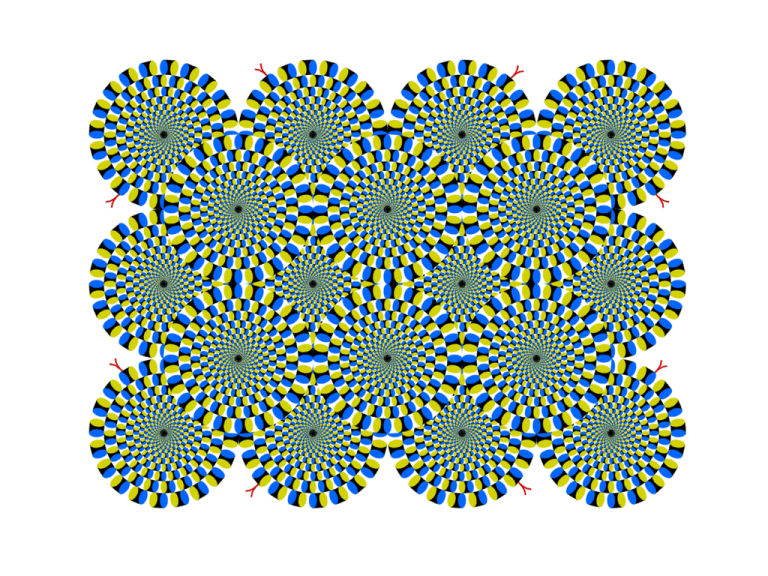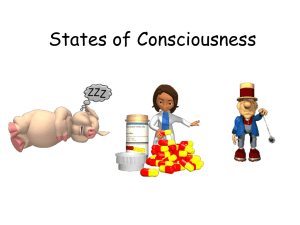General_Psychology_files/Chapter Three Part One 2014 - K-Dub
advertisement

General Psychology Scripture • Matthew 5:7 Blessed are the merciful, for they will receive mercy The merciful - The tender-hearted: they who love others as themselves: They shall obtain mercy - Whatever mercy therefore we desire from God, we should show the same to others. He will repay us a thousand fold, the love we bear to any for his sake. Forms of Consciousness Psychology’s Relationship to this Topic Psychology was once defined as “the description and explanation of states of consciousness.” Now, consciousness is just one topic among many for psychologists. Cognitive neuroscience allows us to revisit this topic and see how the brain is involved. Brain and Consciousness: Findings and Debates Finding Some rare “unconscious” patients have brain responses to conversation. Implication Don’t judge a book by its cover when it comes to consciousness. Debate What is going on in the brain that generates our experience of consciousness? One View Synchronized, coordinated brain activity generates consciousness, or at least is a sign that conscious activity is occurring. Conscious vs. Unconscious Activity: The Dual-Track Mind Conscious “high” track: our minds take deliberate actions we know we are doing Examples: problem solving, naming an object, defining a word Unconscious “low” track: our minds perform automatic actions, often without being aware of them Examples: walking, acquiring phobias, processing sensory details into perceptions and memories Example in the book (borrowed from the Sensation and Perception topic: Automatic processing: Conscious “high” track says, “I saw a bird!” Unconsciously, we see: Think before you act? In one study, students showed brain activity related to pushing a button BEFORE they were aware of their decision to push the button. Does this mean the “decision” is an illusion? Why Have Two Tracks? Possible benefit: not having to think about everything we do all at once Examples You can hit or catch a ball without having to consciously calculate its trajectory. You can speak without having to think about the definitions of each word. You can walk and chew gum AND carry on a conversation. Unusual Consequences of Having a Dual-Track Mind Blindsight Selective Attention Selective Inattention Inattentional blindness Change blindness Choice blindness Blindsight Case Study A woman with brain damage, but NO eye damage, was unable to use her eyes to report what was in front of her. BUT, she was able to use her eyes to help her take actions such as putting mail in slots. What are the two mental “tracks” in this case? Describing the mail and the slot: the “high road,” or conscious track, in this case known as the visual perception track Judging size and distance well enough to put the mail in the slot: the “low road,” or unconscious, automatic track, in this case known as the visual action track Selective Attention There are millions of bits of information coming at our senses every second. So, we have the skill of selective attention; our brain is able to choose a focus and select what to notice. Selective Attention and Conversation The good news: we can focus our mental spotlight on a conversation even when other conversations are going on around us. This is known as the cocktail party effect. The bad news: we can hyperfocus on a conversation while driving a car, putting the driver and passengers at risk. Selective Attention: what we focus on, what we notice Selective Inattention: what we are not focused on, what we do not notice Selective inattention refers to our failure to notice part of our environment when our attention is directed elsewhere. Selective Inattention: inattentional blindness change blindness choice blindness Inattentional Blindness Various experiments show that when our attention is focused, we miss seeing what others may think is obvious to see (such as a gorilla, or a unicyclist). Some “magic” tricks take advantage of this phenomenon. Change Blindness The Switch Two-thirds of people didn’t notice when the person they were giving directions to was replaced by a similar-looking person. By the way, did you notice whether the replacement person was in the same clothes or different clothes? Choice Blindness In one experiment, people chose their favorite among two jams. But when the jar’s contents were deceptively reversed and tasted again, people described the same jar’s contents as their chosen jam. The researcher flips the divided containers, so that the next taste from that jar is actually the other jam. Sleep as a State of Consciousness When sleeping, are we fully unconscious and “dead to the world”? Or is the window to consciousness open? Consider that: we move around, but how do we stop ourselves from falling out of bed? we sometimes incorporate realworld noises into our dreams. some noises (our own baby’s cry) wake us more easily than others. How Do We Learn About Sleep and Dreams? We can monitor EEG/brain waves and muscle movements during sleep. We can expose the sleeping person to noise and words, and then examine the effects on the brain (waves) and mind (memory). We can wake people and see which mental state (e.g. dreaming) goes with which brain/body state. Sleep and Biological Rhythms 24 hour biological “clock” 90 minute sleep cycle Daily Rhythms and Sleep The circadian (“about a day”) rhythm refers to the body’s natural 24-hour cycle, roughly matched to the day/night cycle of light and dark. What changes during the 24 hours? Over the 24 hour cycle, the following factors vary, rising and falling over the course of the day and night: body temperature arousal/energy mental sharpness “Larks” and “Owls” Daily rhythms vary from person to person and with age. General peaks in alertness: evening peak—20-year old “owls” morning peak—50-year old “larks” Sleep Stages and Sleep Cycles: What is Measured? Stages and Cycles of Sleep Sleep stages refer to distinct patterns of brain waves and muscle activity that are associated with different types of consciousness and sleep. Sleep cycles refer to the patterns of shifting through all the sleep stages over the course of the night. We “cycle” through all the sleep stages in about 90 minutes on average. There are four types of sleep. Falling Asleep: From Alert to Alpha Eyes Closed Alpha waves are the relatively slow brain waves of a relaxed, awake state. Falling asleep Yawning creates a brief boost in alertness as your brain metabolism is slowing down. Your breathing slows down. Brain waves become slower and irregular. You may have hypnagogic (while falling asleep) hallucinations. Your brain waves change from alpha waves to NREM-1. Non-REM Sleep Stages Getting deeper into sleep… but not dreaming yet NREM-1 NREM-2 NREM-3 REM Sleep Eugene Aserinsky’s discovery (1953): dreams occurred during periods of wild brain activity and rapid eye movements [REM sleep]. What happens during REM sleep? Heart rate rises and breathing becomes rapid. “Sleep paralysis” occurs when the brainstem blocks the motor cortex’s messages and the muscles don’t move. This is sometimes known as “paradoxical sleep”; the brain is active but the body is immobile. Stages of Sleep: The 90 Minute Cycles Through 8 Hours of Sleep The length of REM sleep increases the longer you remain asleep. With age, there are more awakenings and less deep sleep. NREM-1 NREM-2 NREM-3 Why do we sleep? What determines the quantity and rhythm of sleep? The amount and pattern of sleep is affected by biology, age, culture, and individual variation. Light and the brain regulate sleep. Age: in general, newborns need 16 hours of sleep, while adults need 8 hours or less Individual (genetic) variation: some people function best with 6 hours of sleep, others with 9 hours or more Culture: North Americans sleep less than others, and less than they used to, perhaps because of the use of light bulbs The circadian rhythm is hard to shift (jet lag). This rhythm can be affected by light, which suppresses the relaxing hormone melatonin. Why do we sleep? What does sleep do for us? 1. Sleep protected our ancestors from predators. 2. Sleep restores and repairs the brain and body. 3. Sleep builds and strengthens memories. 4. Sleep facilitates creative problem solving. 5. Sleep is the time when growth hormones are active. Effects of Sleep Loss/ Deprivation Research shows that inadequate sleep can make you more likely to: lose brainpower. gain weight. get sick. be irritable. feel old. Sleep Loss Effects by Body System Sleep Loss/Deprivation=Accident Risk Accident Frequency Sleep loss results in more accidents, probably caused by impaired attention and slower reaction time. Sleep Hygiene How to Sleep Well 1. Turn the lights low and turn all screens off. 2. Eat earlier, and drink less alcohol and caffeine. 3. Get up at the same time every day. 4. Exercise (late afternoon is best). 5. Don’t check the clock; just let it happen. 6. Get counseling for anxiety and depression. Sleep Disorders Are these people dreaming? Night terrors refer to sudden scared-looking • Insomnia: persistent inability behavior, with rapid to fall asleep or stay asleep heartbeat and • Narcolepsy (“numb seizure”): breathing. sleep attacks, even a collapse into REM/paralyzed sleep, at Sleepwalking and sleeptalking run in inopportune times families, so there is a • Sleep apnea (“with no possible genetic basis. breath”): repeated awakening These behaviors, after breathing stops; time in mostly affect bed is not restorative sleep children, and occur in NONREM-3 sleep. They are not considered dreaming. Dreams the stream of images, actions, and feelings, experienced while in REM sleep What We Dream About Dreams often include some negative event or emotion, especially failure dreams (being pursued, attacked, rejected, or having bad luck). Dreams do NOT often include sexuality. We may incorporate realworld sounds and other stimuli into dreams. Dreams also include images from recent, traumatic, or frequent experiences. What We Dream About: (Psychoanalytic Theory) Sigmund Freud believed there was often a hidden “latent content” (conflicts, worries, and urges) underneath the symbolic “manifest content” (the plot, actions, and images recalled) of dreams. Theories about Functions of Dreams Theory Explanation Lacks any Dreams provide a “psychic safety scientific valve”; they often express Wish fulfillment support; otherwise unacceptable feelings, (psychodreams may be and contain both manifest analytic theory) interpreted in (remembered) content and a latent many different content (hidden meaning). But why do we ways. sometimes Dreams help us sort out the day’s Informationdream about events and consolidate our processing This may be things we have memories. true,not but it Regular brain stimulation from REM experienced? does not Physiological The sleep may help develop and explain why we function individual’s preserve neural pathways. experience brain is meaningful REM sleep triggers impulses that weaving the dreams. Activationevoke random visual memories, stories, which synthesis which our sleeping brain weaves still tells us into stories. something Does not Dream content reflects the about the Cognitiveaddress the dreamers’ cognitive dreamer. developmental development—his or her neuroscience of theory dreams. knowledge and understanding. THE EPWORTH SLEEPINESS SCALE no chance of dozing = 0 slight chance of dozing = 1 moderate chance of dozing = 2 high chance of dozing = 3 SITUATION CHANCE OF DOZING Sitting and reading____________ Watching TV____________ Sitting inactive in a public place (e.g a theater or a meeting)____________ As a passenger in a car for an hour without a break____________ Lying down to rest in the afternoon when circumstances permit____________ Sitting and talking to someone____________ Sitting quietly after a lunch without alcohol____________ In a car, while stopped for a few minutes in traffic____________ THE EPWORTH SLEEPINESS SCALE • 1 – 6 Congratulations, you are getting enough sleep! • 7 – 8 Your score is average • 9 and up Seek the advice of a sleep specialist without delay Dreams Dream and Interpretation






